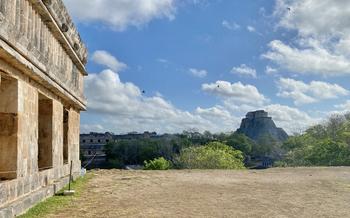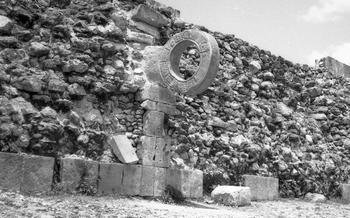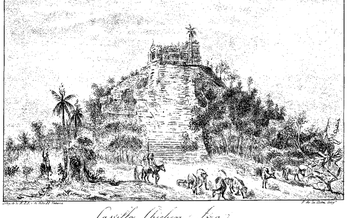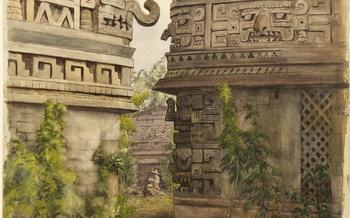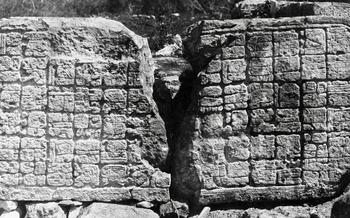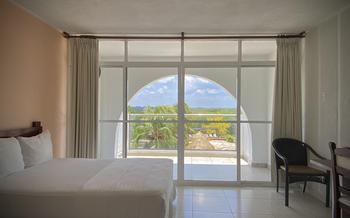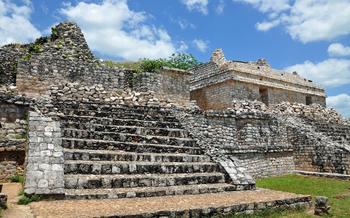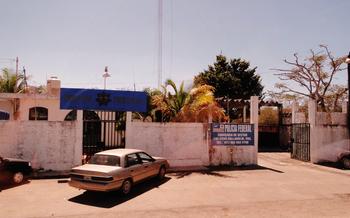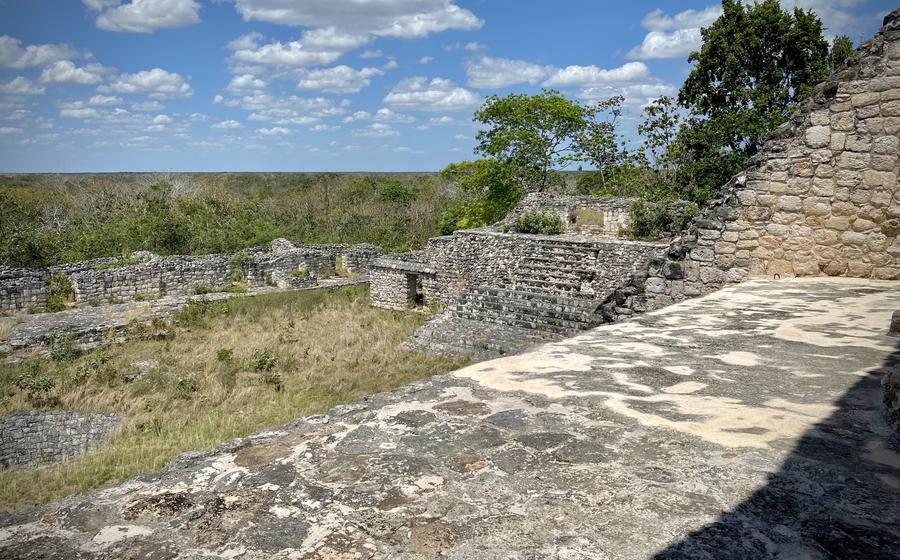
Ek Balam
- Ek Balam: A Hidden Gem of the Yucatan Peninsula
- Exploring the Acropolis: A Majestic Sight
- Unveiling the Mysteries of the Ball Court
- Discovering the Murals of Ek Balam
- Visiting the Cenote Xcanche: A Refreshing Oasis
- Exploring the Residential Areas: A Glimpse into Daily Life
- Learning from the Stelae and Altars: Ancient Inscriptions
- Experiencing the Sounds of the Maya: Mayan Music and Performances
- Tasting the Flavors of Ek Balam: Mayan Cuisine
- Shopping for Souvenirs: Supporting Local Artisans
- Getting Around Ek Balam: Transportation Options
- Staying Safe and Comfortable: Practical Tips
- Planning Your Itinerary: Making the Most of Your Time
- Capturing Memorable Moments: Photography Tips
- Insider Tip: Uncovering Hidden Gems
Ek Balam: A Hidden Gem of the Yucatan Peninsula
Ek Balam, a mesmerizing archaeological site nestled in the heart of the Yucatan Peninsula, beckons history enthusiasts, nature lovers, and adventure seekers alike. Once a thriving Mayan city, Ek Balam now stands as a testament to the ingenuity and artistry of this ancient civilization. Its well-preserved ruins, captivating murals, and scenic cenote offer a glimpse into the rich cultural heritage of the Maya.
Ek Balam's history dates back to the Classic period (250-900 AD), when it served as a significant political and economic center. The site's strategic location along trade routes allowed its inhabitants to amass wealth and influence. Ek Balam's power and prosperity are reflected in the grandeur of its architecture, which rivals that of more famous Mayan cities like Chichen Itza and Uxmal.
Getting to Ek Balam is a breeze, with the site located just a short drive from the popular tourist hub of Valladolid. The journey offers stunning vistas of the Yucatan's lush countryside, dotted with traditional Mayan villages and verdant agave fields. Whether you choose to embark on a self-guided tour or join an organized excursion, the road to Ek Balam is an adventure in itself.
Exploring the Acropolis: A Majestic Sight
The Acropolis, the heart of Ek Balam, stands as a testament to the ingenuity and architectural prowess of the ancient Maya. This colossal structure, towering over the surrounding jungle, is a sight that will leave you in awe. The steep steps leading to the top may challenge your endurance, but the panoramic view from the summit is worth every effort. As you stand atop the Acropolis, you'll feel a rush of exhilaration as you gaze upon the lush jungle canopy stretching in all directions.
The Acropolis and its Significance The Acropolis served as the administrative and ceremonial center of Ek Balam. It was a place where the Maya rulers conducted rituals, held meetings, and received visitors. The architectural style of the Acropolis is a blend of Puuc and Chenes, showcasing intricate carvings and elaborate ornamentation.
Ascending the Steep Steps Climbing the steep steps of the Acropolis is a thrilling experience that will transport you back in time. As you make your way upward, imagine the Maya people who trod these same steps centuries ago. Take your time and savor the journey, allowing the anticipation to build as you approach the summit.
Panoramic Views from the Top Once you reach the top of the Acropolis, you'll be rewarded with breathtaking panoramic views of the surrounding jungle. The vast expanse of the Maya forest stretches out before you, dotted with ancient ruins and hidden cenotes. The feeling of standing atop this ancient structure, surrounded by the beauty of nature, is truly unforgettable.
The Thrill of Exploring Ancient Ruins Exploring the ruins of the Acropolis is like embarking on a journey through time. As you wander among the crumbling walls and intricate carvings, imagine the lives of the Maya people who once inhabited this place. Picture the rulers conducting ceremonies, the priests performing rituals, and the merchants trading goods in the bustling marketplace. Let your imagination run wild as you uncover the secrets of this ancient city.
Unveiling the Mysteries of the Ball Court
The ball court at Ek Balam holds a significant place in Mayan history and culture. It was not just a sports field, but a sacred space where rituals and ceremonies took place. The court is one of the largest and best-preserved in the Yucatan Peninsula, measuring an impressive 150 feet in length. Its walls are adorned with intricate carvings, depicting scenes of the ball game and mythical creatures.
The rules of the ball game are still shrouded in mystery, but it is believed to have been a highly competitive and symbolic sport. Players used their hips and shoulders to keep a heavy rubber ball in play, aiming to hit stone rings mounted high on the walls. These rings, known as "hachas," were believed to represent the underworld, and scoring a goal through them was considered a sacred achievement.
The ball game had deep religious and cultural significance for the Maya. It was believed to represent the struggle between life and death, and victories were often seen as a sign of divine favor. The game was also used to settle disputes, predict the future, and honor important events.
Exploring the ball court at Ek Balam is a unique and immersive experience. Visitors can climb the steep steps to the top of the walls and imagine the roar of the crowd as the game unfolded below. The intricate carvings and the sense of history that permeates the air make the ball court a must-visit for anyone interested in Mayan culture and ancient sports.
Discovering the Murals of Ek Balam
The murals of Ek Balam are a testament to the artistic prowess and cultural significance of the ancient Maya. These vibrant and intricate paintings adorn the walls of various structures throughout the site, offering a glimpse into the lives, beliefs, and mythology of this fascinating civilization.
The murals depict a variety of subjects, including scenes from everyday Mayan life, such as hunting, farming, and trade. They also feature representations of Mayan deities, such as the rain god Chaac and the maize god Yum Kaax. These murals provide valuable insights into the religious beliefs and practices of the ancient Maya.
The process of creating these murals was both complex and time-consuming. The Maya first prepared the walls by applying a layer of limestone plaster. Then, they used natural pigments derived from minerals, plants, and animals to create their vibrant colors. The murals were then carefully painted using brushes made from animal hair or feathers.
The murals of Ek Balam have survived for centuries, despite the harsh tropical climate and the passage of time. Their preservation is a testament to the skill and dedication of the ancient Maya artists. These murals offer a unique and valuable glimpse into the cultural and artistic heritage of this ancient civilization.
Visiting the Cenote Xcanche: A Refreshing Oasis
Ek Balam boasts a hidden gem that offers a refreshing respite from the tropical heat – the Cenote Xcanche. Located a short distance from the main archaeological site, this natural wonder beckons visitors with its crystal-clear waters, lush vegetation, and serene ambiance.
Reaching the cenote is a small adventure in itself, involving a short walk through the jungle. As you approach, the sounds of birdsong and the rustling of leaves fill the air, creating a sense of tranquility. The cenote's entrance is a small opening in the limestone rock, leading to a staircase that descends into the depths of the earth.
Emerging into the cenote's chamber is like stepping into a hidden paradise. The water is a mesmerizing shade of turquoise, reflecting the sunlight that filters through the canopy above. The walls of the cenote are adorned with stalactites and stalagmites, creating a breathtaking natural spectacle.
Swimming or snorkeling in the cenote's refreshing waters is a must-do experience. The water is crystal-clear, allowing you to observe the diverse aquatic life that calls the cenote home. Colorful fish dart in and out of the shadows, while turtles glide gracefully through the water.
It is important to remember that the cenote is a delicate ecosystem, and visitors should treat it with respect. Avoid using sunscreen or insect repellent before entering the water, as these chemicals can harm the cenote's delicate ecosystem.
After your swim, relax on the wooden platform that surrounds the cenote, basking in the warm sunshine and soaking in the natural beauty that surrounds you. Cenote Xcanche is a true oasis, offering a refreshing and rejuvenating experience that will leave you feeling revitalized and connected to nature.
Exploring the Residential Areas: A Glimpse into Daily Life
Beyond the grand structures of the Acropolis and the ball court, Ek Balam offers a glimpse into the daily lives of the ancient Maya through its well-preserved residential areas. These areas, consisting of clusters of stone houses and platforms, provide insights into the domestic architecture, social organization, and economic activities of the city's inhabitants.
Strolling through the residential quarters, you'll encounter various types of structures, including small, single-room houses, larger multi-room dwellings, and elevated platforms used for cooking, sleeping, or storage. The houses typically feature thick stone walls, thatched roofs, and small doorways, providing shelter from the elements and privacy for their occupants.
As you explore these spaces, imagine the hustle and bustle of daily life in Ek Balam. Picture families going about their chores, preparing meals, weaving textiles, or tending to their crops. Observe the intricate designs and carvings adorning the doorways and walls, offering clues about the beliefs and customs of the ancient Maya.
The residential areas also reveal the city's economic activities. Here, you may find evidence of craft production, such as pottery workshops or stone-tool-making areas. Trade and exchange were likely conducted in these spaces, as evidenced by the presence of imported goods and exotic materials.
Exploring the residential areas of Ek Balam is like stepping back in time, allowing you to connect with the lives of the ancient Maya on a personal level. These spaces offer a fascinating glimpse into the daily routines, social interactions, and economic activities that shaped this once-thriving city.
Learning from the Stelae and Altars: Ancient Inscriptions
Stelae and altars, intricately carved stone monuments, stand as testaments to the rich history and culture of the ancient Maya. These enigmatic structures, scattered throughout the archaeological site, offer a glimpse into the lives, beliefs, and accomplishments of this remarkable civilization.
The stelae, tall, rectangular stones, often depict rulers and other important figures adorned in elaborate headdresses and garments. Their surfaces are covered in intricate hieroglyphs, a complex writing system that the Maya used to record historical events, astronomical observations, and religious rituals.
Altars, on the other hand, are typically lower, flat stones that served as platforms for offerings and ceremonies. They are often adorned with intricate carvings depicting Mayan deities, mythical creatures, and scenes from daily life.
Deciphering the Mayan hieroglyphs has been a painstaking and ongoing process, but scholars have made significant progress in translating these ancient texts. Through this work, we have gained valuable insights into Mayan history, including the names and lineages of rulers, important events such as wars and alliances, and the religious beliefs and practices of this ancient civilization.
The stelae and altars of Ek Balam provide a fascinating window into the past, allowing us to connect with the thoughts, beliefs, and aspirations of the Maya who once inhabited this site. They are a testament to the enduring legacy of this ancient civilization and the importance of preserving their cultural heritage.
Experiencing the Sounds of the Maya: Mayan Music and Performances
Music played a vital role in Mayan culture, serving as a means of storytelling, religious expression, and entertainment. The Maya had a rich tradition of music, with a variety of instruments, including drums, flutes, rattles, and whistles. These instruments were often made from natural materials such as wood, bone, and shells, and each had its own unique sound and purpose.
During your visit to Ek Balam, you may have the opportunity to witness a traditional Mayan music performance. These performances often take place in the evenings and feature musicians playing traditional Mayan instruments and singing in the Mayan language. The music is often lively and upbeat, and it is a great way to experience the vibrant culture of the Maya.
Attending a Mayan music performance is a truly unique and memorable experience. It is a chance to connect with the ancient Maya and to learn about their rich cultural traditions. If you are fortunate enough to have the opportunity to see a performance, be sure to take advantage of it.
Tasting the Flavors of Ek Balam: Mayan Cuisine
The ancient Maya were skilled farmers and had a rich culinary tradition that has been passed down through generations. Mayan cuisine is known for its use of fresh, local ingredients, vibrant flavors, and traditional cooking techniques.
When visiting Ek Balam, be sure to savor the opportunity to try some of the delicious Mayan dishes. Must-try dishes include cochinita pibil, a slow-roasted pork dish cooked in banana leaves; panuchos, thick tortillas filled with black beans and topped with shredded turkey or chicken; and salbutes, fried tortillas topped with beans, meat, and vegetables.
Don't miss the chance to try traditional Mayan beverages, such as horchata, a refreshing drink made with rice, cinnamon, and sugar, or balché, a fermented honey drink with a unique flavor.
To fully immerse yourself in the Mayan culinary experience, consider dining in a traditional Mayan restaurant. These restaurants often offer a buffet-style meal, allowing you to sample a variety of dishes.
Remember to ask about the ingredients and preparation methods to gain insights into the Mayan culture and their way of life. Enjoying a meal at a traditional Mayan restaurant is not just a culinary experience but also a cultural one.
Shopping for Souvenirs: Supporting Local Artisans
Ek Balam offers a vibrant array of souvenirs that provide a tangible connection to the region's rich cultural heritage. From intricate handmade crafts to colorful textiles, there's something for every taste and budget. By purchasing souvenirs from local artisans, you not only take home a piece of Ek Balam but also contribute directly to the preservation of traditional Mayan craftsmanship.
When shopping for souvenirs, be sure to visit the local markets or artisan cooperatives. These venues provide a platform for local artisans to showcase their unique creations and earn a sustainable income. You'll find a diverse selection of souvenirs, including intricately woven hammocks, hand-carved wooden sculptures, colorful ceramics, and traditional Mayan clothing.
Before making a purchase, take the time to appreciate the craftsmanship and the stories behind each item. Engage in conversations with the artisans to learn about their techniques, inspirations, and the cultural significance of their work. By doing so, you'll gain a deeper understanding of the Mayan culture and contribute to its continuity.
Remember, purchasing souvenirs from local artisans is not just about acquiring a memento; it's about supporting the livelihoods of skilled craftspeople and preserving a vital part of the Mayan cultural heritage. Every purchase contributes to the sustainability and vibrancy of the local community.
Getting Around Ek Balam: Transportation Options
Exploring Ek Balam on foot is a fantastic way to immerse yourself in the ancient ruins, but for those who prefer a more leisurely experience or have limited mobility, various transportation options are available. Bicycles can be rented at the site's entrance, allowing visitors to pedal along the designated paths and admire the scenery at their own pace. For a more in-depth experience, consider hiring a certified guide. These knowledgeable individuals can provide fascinating insights into the history, culture, and significance of Ek Balam, enhancing your understanding and appreciation of the site. Whichever mode of transportation you choose, remember to respect the site's rules and regulations, such as staying on designated paths and avoiding climbing on the ruins. Embark on your journey through Ek Balam, whether on foot, by bike, or with a guide, and embrace the freedom to explore this captivating archaeological wonder at your own pace.
Staying Safe and Comfortable: Practical Tips
Visiting Ek Balam should be a safe and enjoyable experience. Here are some practical tips to ensure your comfort and well-being during your visit:
-
Essential Items: Pack comfortable shoes, a hat, sunglasses, and sunscreen to protect yourself from the sun. Bring water and snacks, as there are limited food options within the site.
-
Attire: Dress in light, loose-fitting clothing that allows for freedom of movement. Avoid wearing flip-flops or sandals, as the terrain can be uneven.
-
Hydration and Sun Protection: Drink plenty of water throughout your visit to stay hydrated. Apply sunscreen regularly, especially during the midday sun.
-
Respect and Responsibility: Be respectful of the site and its cultural significance. Avoid touching or climbing on the ruins, as this can damage them. Dispose of waste properly to protect the environment.
By following these tips, you can ensure a safe and enjoyable visit to Ek Balam, creating lasting memories of your exploration of this ancient Mayan city.
Planning Your Itinerary: Making the Most of Your Time
When planning your itinerary for Ek Balam, consider your interests and the amount of time you have. If you're short on time, focus on the main highlights, such as the Acropolis, the ball court, and the Cenote Xcanche. For a more comprehensive experience, allow a full day or even longer to explore the entire site, including the residential areas, the stelae and altars, and the various museums.
To avoid crowds, plan your visit during the week or early in the morning. The site is typically busiest in the afternoon and on weekends. It's also a good idea to bring your lunch or snacks, as there are limited food options available within the archaeological park.
No matter how much time you have, make sure to create an itinerary that allows you to explore the site at your own pace and enjoy the unique atmosphere of this ancient Maya city. Whether you're a history buff, a nature lover, or simply looking for a unique and unforgettable experience, Ek Balam has something to offer everyone.
Capturing Memorable Moments: Photography Tips
Ek Balam's captivating ruins, vibrant murals, and serene cenote offer a treasure trove of photo opportunities. To capture the essence of your visit, consider these photography tips:
-
Camera Settings: For sharp and well-exposed shots, set your camera to aperture priority mode (Av or A) and choose an aperture between f/8 and f/1This will ensure that both the foreground and background are in focus.
-
Composition: Experiment with different angles and perspectives to create visually appealing shots. Look for leading lines, such as the steps of the Acropolis or the archways of the ball court, to draw the viewer's eye into the image.
-
Lighting: The best time to photograph Ek Balam is during the golden hours, just after sunrise or before sunset, when the soft, warm light casts a magical glow on the ruins.
-
Murals: To capture the intricate details of the murals, use a wide-angle lens and position yourself close to the wall. Adjust your exposure to ensure that the colors are vibrant and true to life.
-
Cenote: For stunning shots of the cenote, use a waterproof camera or housing to capture the crystal-clear waters and lush vegetation. Experiment with different angles, including overhead shots from the platform or underwater shots to showcase the vibrant marine life.
Insider Tip: Uncovering Hidden Gems
While exploring Ek Balam, don't limit yourself to the main ruins. Venture beyond the beaten paths to discover hidden gems that most visitors miss. Explore the smaller structures, climb the less-frequented pyramids, and immerse yourself in the tranquility of the surrounding jungle.
Seek out knowledgeable guides who can share hidden stories and insights about Ek Balam. They can lead you to secluded spots, point out intricate carvings, and unveil the secrets of this ancient city. With their expertise, you'll gain a deeper understanding and appreciation for the site.
The thrill of uncovering hidden gems is unparalleled. It's like being an explorer on an archaeological expedition, discovering something that few others have seen. These hidden treasures will leave you with a sense of wonder and a lasting memory of your Ek Balam adventure.
So, embrace your inner explorer, step off the beaten path, and uncover the secrets that Ek Balam holds. You won't be disappointed.

